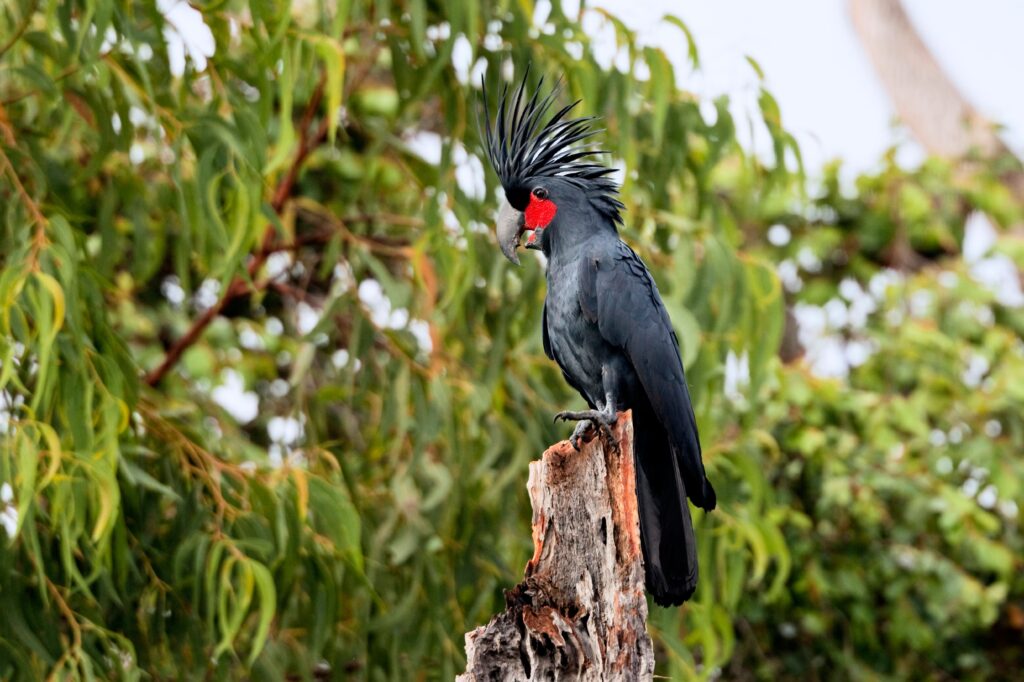Cape York Peninsula is globally recognised for its unique combination of climatic, geographic and ecological conditions and supports natural and cultural values of international significance.
The region supports a diverse range of habitats and landscapes including wetlands, rainforests, savannas, heathlands and coastal dunes which are home to many species of plants and animals found nowhere else in either Australia or the world.
Once forming a direct land bridge to New Guinea, the region supports a globally unique combination of old-world Gondwanan and more modern Asian plants and animals. This combination of evolutionary influences contributes to the diverse ecological features seen in Cape York, making it a critical area for understanding the evolution and interconnectedness of Earth’s ancient and modern ecosystems.
Iconic species such as the Palm Cockatoo, Green Tree-python, Spotted Cus-cus and Eclectus Parrot are found nowhere else in Australia. The region also boasts its own suite of frogs, reptiles and birds found nowhere else in the world including the Golden-shouldered Parrot. There are 83 rare or threatened animals found across Cape York.

Throughout the region First Nations people, groups and organisations are leading efforts to protect Country form inappropriate development, invasive species, uncontrolled fires and return cultural land management.
Protecting Cape York’s biodiversity and landscapes rich in living cultural heritage is of global importance. Current initiatives by the Queensland and Federal Governments are welcomed and include:
- The expansion and resourcing of Indigenous Protected Areas
- The return of land under the Cape York Tenure Resolution Program,
- National Heritage assessments, and
- Facilitating an Indigenous led and consent-based World Heritage nomination process.
However, there remain many threats.
Mining activity is escalating across the region and some of the most significant and intact landscapes are under threat from strip mining for bauxite, silica, and other minerals.
But amongst the threats there are solutions and many success stories.
Landscapes under threat
In the global race for critical minerals, we are seriously concerned about the adverse impacts for nature, global heritage and First Nations rights and interests as resource applications are rushed through. We are seeing this happening now in an ecologically and culturally important area of Cape York.

Just north of Hope Vale on Cape York’s eastern coastline stretches a vast landscape of internationally significant sand dunes. Representing some of the largest and most intact examples of parabolic dune formations in the world, the white silica sands found across approximately 50,000 hectares of remote landscapes including tropical rainforests, wetlands, heathlands and myriad coastal habitats.
Pic: the sacred Guti site is of invaluable cultural significance to the Binthi people and is a dramatic example of a parabolic dune in an unprotected landscape east of Hopevale. Photo: Kerry Trapnell & used with permission from the Binthi LHG Aboriginal Corporation.
Wedged between the Great Barrier Reef World Heritage Area and the expansive national parks of southern Cape York Peninsula, this stretch of Aboriginal land has attracted the mining industry for decades. Awash with exploration permits and mining lease applications, the area has long been celebrated as an area of unparalleled state, national and international significance.
A review of studies and reports dating back 30 years reveals the dune field landscape under threat from mining supports a staggering wealth of natural and geological values likely to meet World Heritage criteria.
With both the Queensland and Federal governments committed to advancing a World Heritage nomination for appropriate areas of Cape York should there be Traditional Owner consent, the race to exploit the regions minerals threatens to undermine this process.
Many Traditional Owners have voiced open and public concern about the extent and rate of mining and exploration that is occurring within the area. Dhaarrba elder and spokesperson Richard Bowen states:
“it was very heartbreaking to see, where the miners are today…
We don’t want any more minings to go ahead…
we don’t want it because it will only destroy our land.”
Dhaarrba Elder Richard Bowen. Photo: Kerry Trapnell and used with permission from Dhaarrba Land Trust.

Traditional Owner groups in the area have been developing healthy country plans and exploring ways they can protect and look after their country. They are seeking support for and IPA, heritage recognition and establishing ranger groups to actively work on their country.
Video used with permission from The Australian, original video filmed by Kerry Trapnell.
Support for the Tenure Resolution Program
Since 1995, Queensland’s Landmark Cape York Tenure Resolution Program has returned 4.3 million hectares of land to Aboriginal ownership. Pew, QCC and Balkanu are working together to ensure this program continues to deliver cultural and conservation outcomes.
This program delivers a leading consent-based model of negotiating new Aboriginal owned national parks, and has been supported by successive Queensland governments of all persuasions for nearly 20 years. This model has been extended to the World Heritage-listed Daintree National Park.
The benefits of joint management include diversified employment opportunities and an increase in revenue streams for national parks. There are also significant socio-economic benefits, with an increasing number of Indigenous rangers across the sector. Career opportunities, niche tourism and cultural maintenance all arise from this joint management approach and the growth in land management enterprises.
Indigenous owned and jointly managed national parks cover 2.3 million hectares of land on Cape York. When combined with private protected areas across Indigenous and pastoral land, this results in nearly 4 million hectares of Cape York being protected – 35% of the region.
Cape York Peninsula is now one of the best protected regions of Australia – which has been made possible through a long-supported increase in First Nations leadership of national park management.
With continued investment, the Cape York model of Indigenous owned and jointly managed national parks will make an invaluable contribution to meeting the Federal Government’s commitment to protect 30% of Australia’s land by 2030.
We support the leadership of Queensland’s First Nations peoples in the ongoing management of protected areas and their free, prior and informed consent in its expansion.



